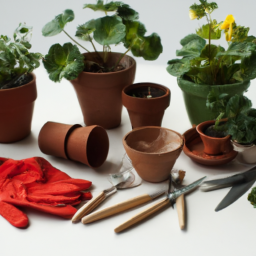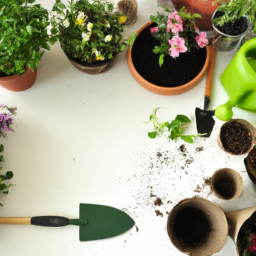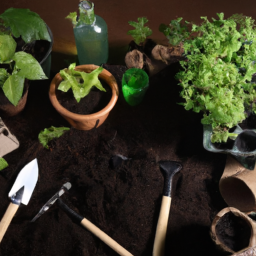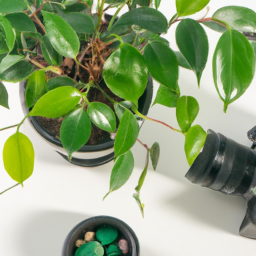
Welcome to our blog post on “Green Beginnings: Your Journey into Indoor Gardening”! If you’ve ever dreamed of having a lush garden but lack the outdoor space or live in a climate that isn’t conducive to traditional gardening, then indoor gardening is the perfect solution for you. Whether you’re a seasoned gardener or a complete novice, this post will guide you on how to embark on your own green journey right from the comfort of your own home. So, let’s dive in and discover the wonders of indoor gardening together!
The Benefits of Indoor Gardening: Enhancing Your Living Space with Greenery
Welcome to the world of indoor gardening! Whether you have a green thumb or are just starting to explore the wonders of plants, indoor gardening is a fantastic way to bring nature indoors and enhance your living space. In this guide, we will take you on a journey into the world of indoor gardening, exploring its benefits and providing you with a step-by-step guide to get started.
Bringing Nature Inside
Indoor gardening allows you to create a lush and vibrant environment within the comfort of your own home. By bringing nature inside, you can enjoy the beauty and serenity of plants all year round, regardless of the weather outside. Not only do indoor plants add a touch of greenery to your living space, but they also provide numerous benefits for your physical and mental well-being.
One of the key benefits of indoor gardening is the improvement of air quality. Plants naturally purify the air by removing toxins and releasing oxygen. This can help to reduce indoor air pollution and create a healthier living environment. Additionally, studies have shown that being around plants can lower stress levels, improve concentration, and boost mood. So, by incorporating indoor plants into your home, you can create a calming and rejuvenating atmosphere.
Furthermore, indoor gardening allows you to connect with nature on a deeper level. Taking care of plants can be a fulfilling and rewarding experience. It provides an opportunity to nurture and watch your plants grow, which can bring a sense of accomplishment and joy. Indoor gardening can also serve as a creative outlet, allowing you to experiment with different plant varieties, arrangements, and decorative elements to suit your personal style.
Getting Started with Indoor Gardening
Now that we have explored the benefits of indoor gardening, let’s dive into the steps to get started on your own indoor garden:
1. Assess Your Space: Take a look around your home and identify suitable areas for your indoor garden. Consider factors such as natural light availability, temperature, and humidity. Different plants have different requirements, so it’s important to choose plants that will thrive in your specific environment.
2. Choose the Right Plants: Select plants that are well-suited for indoor growing. Some popular choices include spider plants, pothos, peace lilies, and succulents. Research the care requirements of each plant to ensure you can provide the necessary conditions for their growth.
3. Gather Your Supplies: Assemble the necessary tools and materials for your indoor garden. This may include pots or containers, potting soil, fertilizers, watering cans, and gardening gloves. Make sure to choose pots with drainage holes to prevent overwatering.
4. Prepare Your Soil: Use a high-quality potting mix that is suitable for indoor plants. Avoid using garden soil, as it may contain pests, diseases, or weed seeds. Fill your pots with the potting mix, leaving some space at the top for watering.
5. Plant Your Seeds or Seedlings: Follow the instructions provided with your seeds or seedlings for the best results. Make sure to plant them at the appropriate depth and provide adequate spacing between plants. Gently water the soil after planting.
6. Provide Proper Care: Each plant has specific care requirements, so it’s important to understand and fulfill those needs. This includes watering, fertilizing, pruning, and monitoring for pests or diseases. Regularly check the soil moisture levels and adjust your watering schedule accordingly.
7. Monitor and Adjust: Observe your plants regularly and make adjustments as needed. If a plant is not thriving in its current location, try moving it to a spot with better lighting or adjust the watering frequency. Indoor gardening is a continuous learning process, and you will become more attuned to the needs of your plants over time.
8. Enjoy the Fruits of Your Labor: As your indoor garden grows and flourishes, take the time to appreciate the beauty and benefits it brings to your living space. Regularly prune your plants to maintain their shape and encourage healthy growth. Share your indoor gardening journey with others and inspire them to embark on their own green beginnings.
Indoor gardening is a wonderful way to create a harmonious and inviting living space. By incorporating plants into your home, you can enjoy the numerous benefits they provide, from improved air quality to reduced stress levels. Follow these steps to embark on your journey into indoor gardening and let the greenery transform your living space into a tranquil oasis.

Essential Tools and Supplies for Successful Indoor Gardening
Indoor gardening is a wonderful way to bring the beauty and benefits of plants into your home. Whether you have a small apartment or a spacious house, creating an indoor garden can be a rewarding and fulfilling experience. To ensure your indoor garden thrives, it is essential to have the right tools and supplies. In this guide, we will walk you through the must-have items for successful indoor gardening.
1. High-Quality Potting Mix
The foundation of any successful indoor garden starts with the right potting mix. Unlike outdoor gardens, indoor plants rely solely on the soil you provide. A high-quality potting mix ensures that your plants receive the necessary nutrients, moisture, and aeration to grow healthy and strong.
Look for a potting mix specifically formulated for indoor plants. These mixes are typically lightweight and well-draining, allowing excess water to flow out easily. Avoid using garden soil or outdoor potting mix, as they can be too heavy and may not provide adequate drainage for your indoor plants.
When choosing a potting mix, consider the specific needs of your plants. Some plants, such as succulents and cacti, prefer a well-draining mix with added perlite or sand. Others, like tropical plants, thrive in a mix that retains moisture for longer periods.
2. Proper Containers
The right containers are crucial for indoor gardening success. When selecting containers, consider the size, drainage, and material.
Choose containers that are appropriate for the size of your plants. If your plants are small, opt for smaller pots to prevent excess soil moisture. Larger plants, on the other hand, may require bigger containers to accommodate their root systems.
Ensure that your containers have drainage holes at the bottom. Proper drainage prevents water from pooling, which can lead to root rot and other plant diseases. If you fall in love with a container that lacks drainage holes, you can create them yourself using a drill or a hot nail.
When it comes to material, there are various options available, including plastic, ceramic, terracotta, and fabric. Plastic containers are lightweight and retain moisture well, while terracotta pots are porous and allow for better airflow. Choose the material that suits your plants’ needs and your personal style.
3. Watering Can or Spray Bottle
Watering is an essential part of indoor gardening, and having the right tools for the job is crucial. A watering can or a spray bottle can make the process easier and more efficient.
If you have a large indoor garden or several plants, a watering can with a long spout is recommended. This allows you to reach all your plants without causing water damage to their leaves or stems. Opt for a watering can with a detachable rose attachment, which provides a gentle shower-like spray.
For smaller plants or those that require more controlled watering, a spray bottle is a great tool to have. Spray bottles allow you to mist your plants, providing them with the humidity they need, especially in dry indoor environments.
4. Pruning Tools
Pruning is an essential practice in indoor gardening to maintain the health and shape of your plants. Having the right pruning tools ensures clean cuts and prevents damage to your plants.
A pair of sharp, clean pruning shears is a must-have tool for any indoor gardener. Use them to remove dead or yellowing leaves, trim overgrown branches, or shape your plants. Make sure to clean your pruning shears with rubbing alcohol after each use to prevent the spread of diseases.
In addition to pruning shears, consider investing in a pair of scissors or snips for more delicate pruning tasks. These tools are particularly useful for trimming herbs or small indoor plants.
5. Plant Fertilizer
Indoor plants rely on you for their nutritional needs, and regular fertilization is essential for their growth and vitality. Choose a plant fertilizer suitable for indoor use and follow the instructions for application.
There are various types of fertilizers available, including liquid, granular, and slow-release options. Liquid fertilizers are easy to use and quickly absorbed by plants, while granular fertilizers are applied to the soil surface and release nutrients over time. Slow-release fertilizers are convenient for busy gardeners, as they provide a steady supply of nutrients for several months.
Remember to fertilize your plants in moderation, as overfertilization can lead to nutrient burn and other issues. Always read and follow the instructions on the fertilizer packaging to ensure you are providing the right amount for your plants.
By having these essential tools and supplies, you are well on your way to a successful indoor gardening journey. Remember to choose high-quality potting mix, suitable containers, and invest in pruning tools, watering cans or spray bottles, and plant fertilizer. With the right equipment and a little bit of care, your indoor garden will flourish, bringing joy and beauty to your home.

Choosing the Right Plants for Your Indoor Garden: Tips and Recommendations
Welcome to the wonderful world of indoor gardening! Whether you are a seasoned plant enthusiast or just starting your green journey, choosing the right plants for your indoor garden is crucial for success. In this guide, we will provide you with valuable tips and recommendations to help you make informed decisions and create a thriving indoor garden.
Understanding Your Indoor Environment
Before diving into plant selection, it’s important to assess your indoor environment. Factors such as lighting, temperature, humidity, and available space will significantly influence the types of plants that will thrive in your indoor garden.
Lighting: Most indoor plants require bright, indirect light. Assess the natural light sources in your space, such as windows or skylights. North-facing windows provide the least amount of light, while south-facing windows offer the most. East and west-facing windows provide moderate light levels. If your space lacks natural light, consider supplementing with artificial grow lights.
Temperature: Indoor plants generally prefer temperatures between 60-75°F (15-24°C). Avoid placing your plants near drafts or heating/cooling vents, as extreme temperature fluctuations can stress them.
Humidity: Most indoor environments have lower humidity levels than plants prefer. Increase humidity by placing a tray of water near your plants or using a humidifier. Alternatively, group plants together to create a microclimate with higher humidity.
Available Space: Consider the available space in your home for your indoor garden. Do you have ample floor space for larger plants, or do you need to focus on smaller varieties that can thrive on tabletops or shelves? Determine how much space you can allocate for your plants.
Choosing the Right Plants
Now that you have a good understanding of your indoor environment, it’s time to choose the perfect plants for your indoor garden. Here are some tips and recommendations to guide you:
1. Assess Your Gardening Skills: Consider your level of gardening experience. If you are a beginner, it’s best to start with low-maintenance plants that are more forgiving. As you gain confidence and experience, you can gradually introduce more challenging varieties.
2. Consider Light Requirements: Match the light requirements of plants with the available light in your space. Low-light plants like pothos, snake plants, and ZZ plants are great for areas with minimal natural light. Medium-light plants such as philodendrons, spider plants, and peace lilies thrive in moderate light conditions. High-light plants like succulents, orchids, and citrus trees require bright, direct light.
3. Evaluate Space Constraints: Take into account the available space in your indoor garden. If you have limited floor space, consider hanging plants like pothos, spider plants, or ferns. For small tabletops or shelves, opt for compact plants like succulents, cacti, or air plants. If you have ample floor space, explore larger plants such as fiddle leaf figs, monstera deliciosas, or bird of paradise.
4. Consider Maintenance Requirements: Different plants have varying maintenance needs. Some plants require frequent watering, while others are drought-tolerant. Assess your ability to provide the necessary care for your chosen plants. If you have a busy schedule or tend to forget watering, opt for plants that can withstand occasional neglect, such as snake plants, pothos, or ZZ plants.
5. Explore Your Plant Preferences: Finally, consider your personal preferences and the aesthetic you want to achieve in your indoor garden. Do you prefer lush foliage, colorful flowers, or unique shapes? Research different plant varieties and select those that align with your taste and vision.
Reaping the Benefits of Indoor Gardening
Once you have carefully chosen the right plants for your indoor garden, it’s time to enjoy the numerous benefits of indoor gardening:
1. Improved Air Quality: Indoor plants act as natural air purifiers, removing toxins and releasing oxygen. They can help reduce indoor air pollution and create a healthier living environment.
2. Stress Relief: Gardening has been proven to reduce stress levels and promote relaxation. Indoor gardening provides an opportunity to connect with nature and find solace in nurturing living plants.
3. Aesthetically Pleasing: Indoor plants add beauty and vibrancy to any space. They can transform a dull room into a lush oasis, creating a calming and visually appealing atmosphere.
4. Connection with Nature: Even if you live in a bustling city or lack outdoor space, indoor gardening allows you to experience the joy of nature firsthand. It fosters a sense of connection with the natural world and promotes overall well-being.
5. Learning and Growth: Indoor gardening provides an excellent opportunity to learn about different plant species, their growth habits, and care requirements. It allows you to develop new skills and expand your knowledge as a gardener.
Remember, each plant is unique, and it may take some trial and error to find the perfect match for your indoor garden. Be patient, observe your plants closely, and adjust their care as needed. With time, you will develop a green thumb and create a thriving indoor garden that brings joy and tranquility to your life.
Here are the Essential Points
Are you tired of your plain and lifeless living space? Looking for a way to bring some freshness into your home? Well, look no further! Indoor gardening might just be the answer you’ve been searching for. Whether you have a green thumb or not, this blog post will guide you on your journey to creating a lush and vibrant oasis right inside your own home.
Indoor gardening is the perfect way to add a touch of nature to any room, no matter how small or cramped it may be. Not only does it improve the aesthetic appeal of your space, but it also has numerous health benefits. Plants are natural air purifiers, removing toxins and releasing oxygen, which can improve air quality and promote a sense of calm and well-being. Plus, taking care of plants can be a therapeutic and rewarding experience. So, why not give it a try? In this blog post, we will cover everything you need to know to get started with indoor gardening, from choosing the right plants for your space to providing them with the proper care and maintenance. So, get ready to embark on your green journey and transform your home into a lush and inviting sanctuary.
Curious Minds Asked, We Responded. Frequently Asked Questions:
Q1: What is indoor gardening and why is it gaining popularity?
A1: Indoor gardening refers to the practice of growing plants inside a controlled environment, typically within a home or office. It has gained popularity due to several reasons. Firstly, it allows people to enjoy gardening regardless of limited outdoor space or unfavorable weather conditions. Secondly, indoor plants have been proven to improve air quality, reduce stress, and enhance overall well-being. Lastly, indoor gardening provides an opportunity to grow fresh herbs, vegetables, and flowers year-round, promoting sustainability and self-sufficiency.
Q2: How do I get started with indoor gardening?
A2: Getting started with indoor gardening is easier than you might think! Here are a few steps to begin your journey:
1. Choose the right plants: Consider the lighting conditions in your home and select plants that thrive in those conditions.
2. Gather essential supplies: Get pots or containers, potting soil, fertilizers, and any necessary tools like a watering can or pruning shears.
3. Create a suitable environment: Ensure your plants have access to adequate light, temperature, and humidity levels. Consider using grow lights if natural light is limited.
4. Water and care for your plants: Follow watering guidelines specific to each plant and regularly monitor their growth. Don’t forget to provide proper nutrition and occasional pruning.
5. Enjoy the process and learn: Indoor gardening is a continuous learning experience, so don’t be afraid to experiment and seek guidance from gardening communities or online resources.
Q3: What are the best plants for indoor gardening beginners?
A3: As a beginner, it’s best to start with plants that are relatively easy to care for and resilient. Here are some popular choices:
1. Spider Plant: Known for its air-purifying qualities and adaptability to various light conditions.
2. Snake Plant: Thrives in low light and requires minimal watering, making it perfect for busy individuals.
3. Pothos: A trailing vine that can tolerate low light and irregular watering.
4. Peace Lily: Known for its elegant white flowers and ability to thrive in low-light environments.
5. Aloe Vera: Requires minimal maintenance, as it prefers infrequent watering and bright, indirect light.
Remember to research each plant’s specific care requirements to ensure their well-being.
Q4: Can I grow vegetables and herbs indoors?
A4: Absolutely! Indoor gardening provides an excellent opportunity to grow your own fresh vegetables and herbs. Many plants can be successfully grown indoors, such as cherry tomatoes, lettuce, peppers, basil, parsley, and mint. However, it’s important to consider the space, lighting, and temperature requirements for each specific plant. Some vegetables may require larger containers or trellises for support, while others may need additional lighting, such as grow lights, to supplement natural sunlight. With proper care and attention, you can enjoy a bountiful harvest of homegrown produce.
Q5: How do I prevent common indoor gardening problems like pests and diseases?
A5: Preventing pests and diseases is crucial for maintaining healthy indoor plants. Here are a few tips to help you tackle these issues:
1. Maintain cleanliness: Keep your indoor gardening area clean by regularly removing dead leaves, debris, and fallen flowers.
2. Monitor humidity levels: Excessive humidity can lead to fungal diseases, so ensure proper air circulation and avoid overwatering.
3. Check for pests: Regularly inspect your plants for signs of pests like aphids, spider mites, or fungus gnats. If detected, treat them with organic pest control methods or insecticidal soaps.
4. Quarantine new plants: Before introducing new plants to your indoor garden, quarantine them for a few weeks to ensure they are pest and disease-free.
5. Research and learn: Educate yourself about common pests and diseases that affect indoor plants. This knowledge will help you identify and address issues promptly.
By following these preventative measures and promptly addressing any problems, you can keep your indoor garden thriving and pest-free.
Dr. Olivia Green is a botanist with over two decades of experience in indoor plant cultivation. She holds a Ph.D. in Plant Biology and has dedicated her career to researching plant behavior in controlled environments. Dr. Green is passionate about helping plant enthusiasts master the art of indoor gardening through her extensive knowledge and practical insights.


